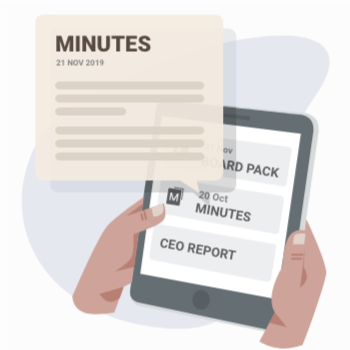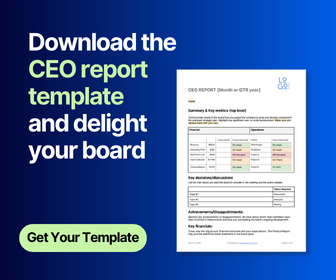Top Tips for managing the board meeting cycle
One of the key governance responsibilities of the Chair and CEO is to manage the preparation process leading up to the board meeting and the actions subsequently agreed. Establishing a governance cadence not only helps the board examine matters that move the company forward, but also provides an opportunity to ensure the Management and Board are rowing in the same direction.
There are important annual governance processes that need to be scheduled within the annual board cycle. These include regular reviews of strategy, evaluation of the annual work plan and budget, regular risk reviews and CEO performance evaluations. It is essential for effective corporate governance that the meeting cycle includes time for an evaluation of board performance and self-reflection.
This article focuses on the board meeting cycle that sits within the annual calendar.
Pre meeting
Agenda preparation
- The responsibility for preparing the board agenda can either sit with the Chair or the CEO however best practice suggests an iterative agenda development approach with the CEO and Chair working collaboratively to finalise the agenda. The Chair and CEO will determine how best they work together and include key items along with the meeting running order. This is best achieved by open discussion among board member, making enough time available, and considering the preferred board working styles.
- The responsibility for final approval of the agenda always sits with the Chair.

- The Chair can seek input from other directors on new or strategically important items that may require additional time within the board agenda. This could include information or issues that have surfaced since the last Board meeting that may have a bearing on the industry / company, items where more clarity is required, or items or issues that sit in the wheelhouse of other directors.
- The Agenda will include items from the annual meeting cycle, strategically important issues and operational matters that the board is accountable for (e.g. risk & health and safety). The agenda should provide sufficient time to discuss these topics.
- Best practice suggests that strategically important papers should be addressed first on the agenda with more administrative matters being considered towards the end of the agenda.
Board pack and meeting preparation
- Generally, the CEO or board administrator will prepare the board pack. Utilising a standard format helps executives and directors complete and absorb information more efficiently.
- Section reports received from direct reports should be summarised and reviewed for consistency by the CEO. The key highlights should be included in a CEO / Executive Summary.
- Board papers with recommendations should be succinct – ideally the board pack (including reports) should be around 10 to 20 pages max. Where helpful supporting material can aid the Board's decisions, these can be added as an appendix.
- The board pack should ideally be with directors the week before (and at least a weekend before) the board meeting – it is important that the Board is provided with enough “thinking” time before the meeting.
At the board meeting
Board only time
- Board meetings should include upfront time where the directors can canvas any burning issues and prepare for how these are best shared with the executive.
- One of the considerations in board only time is who stays in the room at this time? If the board utilises a Managing Director (MD), the Board may prefer that they are not present for this discussion. If an Executive Chair (EC) is in place, that person may absent themselves, with the senior Board role falling to the Lead Independent Director.
- The key points from board only discussion, can where appropriate, be shared once the executive(s) enter the room. This may at times result in changes to (the order and timings of) the agenda.
- The Chair / Leading Independent Director with the agreement of directors may defer certain items to discuss offline with the CEO/MD/EC after the meeting where items are more sensitive or confidential in nature and / or would disrupt the flow of the meeting.
Discussion and decision on board matters
- Best practice suggests that the most efficient boards establish a time schedule for each item on the agenda. This acts as a guidance for the Chair and board members. One of the key roles of the Chair is the time management of the board meetings.
- During Board discussions, the Chair has the responsibility to ensure all director’s views are canvassed. This often requires considerable skills to ensure the less forward board members share their thoughts.
- At the conclusion of the discussion, the Chair will summarise the discussion and actions agreed to ensure the Board’s deliberations and decisions are accurately minuted.
- At the conclusion of the meeting, the Chair should canvas the room for feedback on how the meeting was conducted. What did we do well? What could we do better? What might we change / try at the next meeting? This should be a forward-looking constructive discussion among board members and can often include an acknowledgement of the contribution / success of key executives.
Post meeting
Between meetings
- The Minutes from the meeting should be with the Chair for approval within two to three working days and ideally be circulated to every board member within one week of the meeting.
- A helpful pattern for organisations to establish is for the Chair to check in with directors and the CEO post the Board meeting and set out a direction for the next meeting.
- A regular catch up will usually occur between the CEO and the Chair between board meetings. The catch-up need not be onerous for smaller , fast moving organisations i.e A 20 minute call scheduled weekly and finished early if there is nothing significant to cover.
- The preference for Chair/CEO meetings is for them to be conducted face to face – where possible. Time and location pressures can render this unachievable, but video conferencing technology can help.
Completing meeting actions
- Performance / follow up on actions should ideally be completed in advance of the next board meeting. Minutes will usually specify when completion is expected – especially if later than a board cycle. Issues encountered along with completing approved actions should be outlined to the CEO and/or Chair with a recommended course of action to resolve.

- Boards may defer sign off on items e.g. the final budget which may require final management adjustments between meeting cycles. These may be provisionally approved mid meeting cycle via email. Such instances should be ratified / recorded as approved within the next meeting minutes.
- If Board sub-committees are utilised, the minutes and any approved actions from these committees are usually presented to the Board, included in the meeting pack. These should be noted in the minutes of the main board
- Establishing and maintaining a good governance rhythm to your board meeting cycle should allow strategic and operational items to be handled well. This allows the Board to fulfil its governance role effectively and management sufficient space to concentrate on its relentless execution of the approved strategy.
Want to know how your board of directors and managers can be more productive and efficient through the use of technology? With BoardPro board software, you can centralise board information, get organised, save time, and reduce hassle. With BoardPro, everything is just a couple of clicks away.
Share this
You May Also Like
These Related Stories

Seven costly mistakes of today’s board packs and how to fix them

How to Run Robust Board Meeting Cycles


